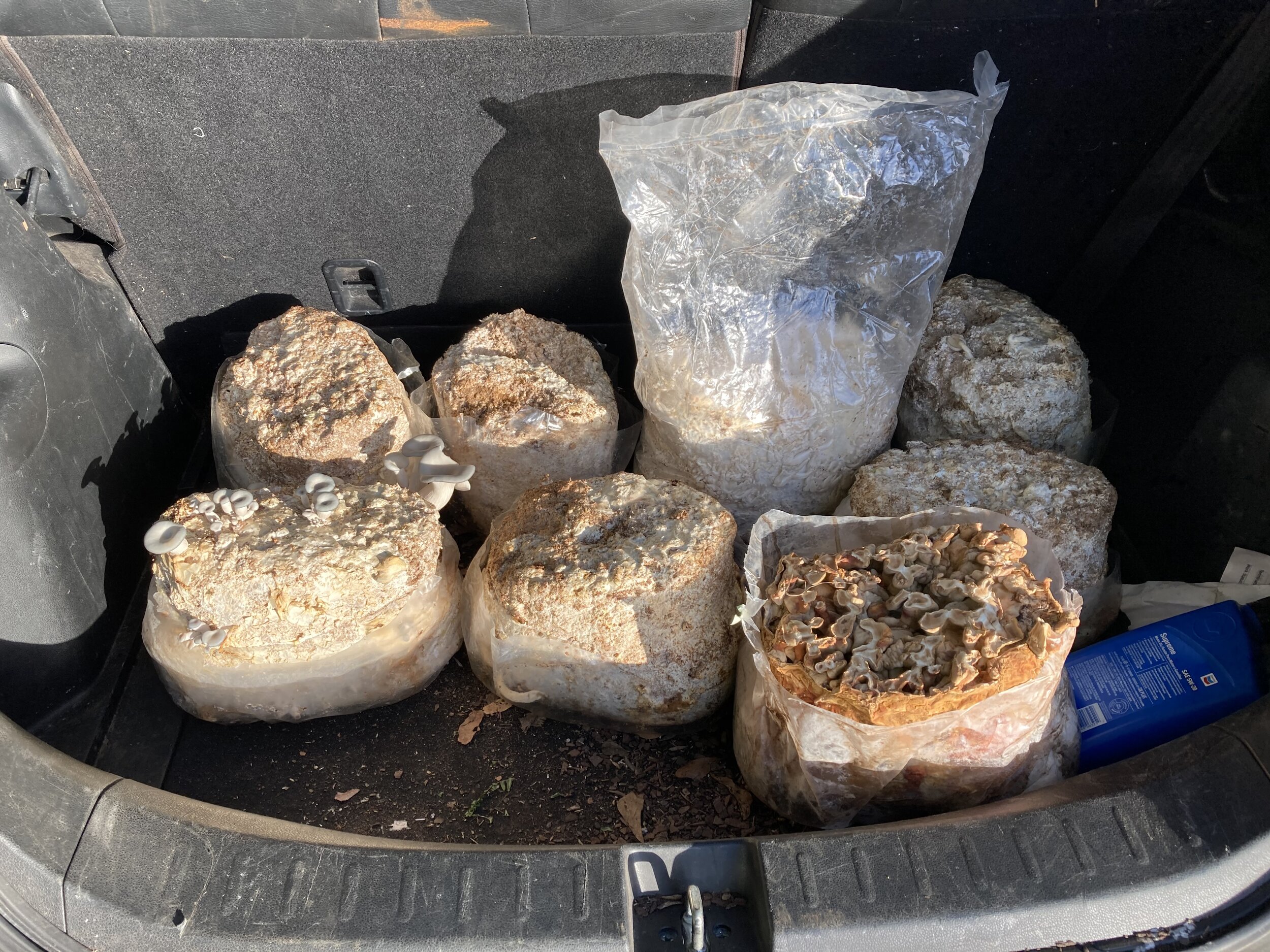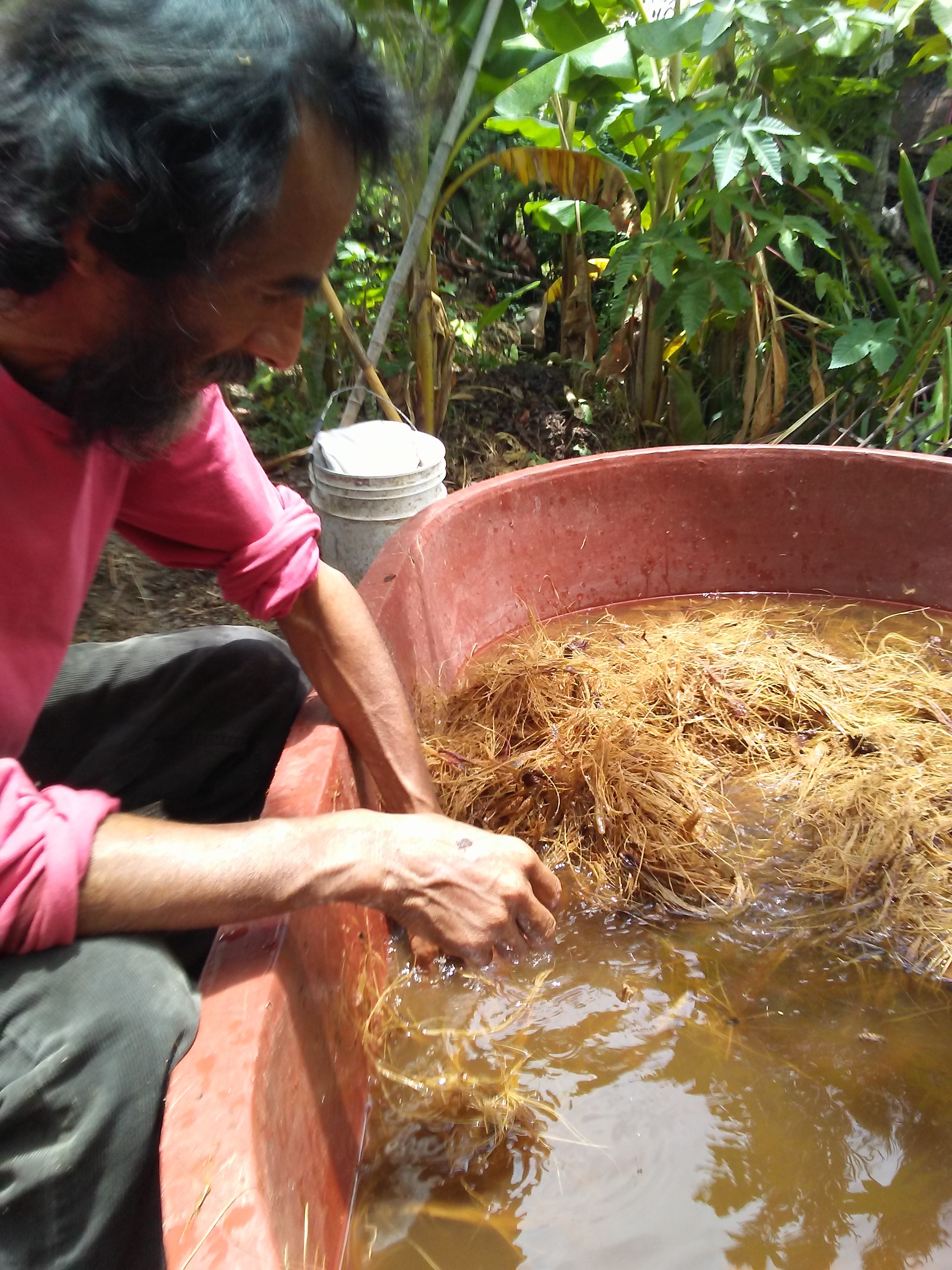Beating hemlock bark in Tuscaloosa, 2022
For my newest book Hemlock, I was mostly making paper from home.
This started in 2021 when COVID was still a big factor. I had also graduated and lost studio access at The University of Alabama and was working full time. Later, with the book still not finished, I moved across the country to start a new job in Colorado.
This whole project was a study in how to make paper + a book with two smallish moulds, a home setup, and many different life distractions.
I began my papermaking process by setting up a useable mobile paper studio in my backyards in Tuscaloosa then Birmingham, Alabama.
I knew wanted to start by making small paper samples using a mixture of hemlock bark, kozo, and abaca. Abaca can be ordered in sheets from Carriage House. The kozo was easy enough— it grows wild in Alabama and I had already scouted out multiple spots to harvest from. It just takes some labor to process. But where would I get the hemlock?
I didn’t feel it was ethical to harvest hemlock bark from wild places in Alabama (the hemlock woolly adelgid hasn’t hit there yet so there are tons of healthy trees). I found some from a fallen tree and used it for sample sheets; but then luckily, when I moved to Birmingham, I discovered hemlock trees everywhere!
In fact, my back neighbor had many large hemlock trees in his yard:
No cats were harmed in the making of the video below. (I don’t normally put them on leashes connected to propane tanks, this was an experiment that mostly failed.)
Sidenote: I’ve tended to get lucky with papermaking in the places I’ve lived. My yard in Tuscaloosa was full of kozo (paper mulberry) trees and there was a huge plot of them just steps from my house in an abandoned lot. During a tornado warning storm on Easter 2020, a big kozo tree in my yard fell on power lines, knocking out power to the entire neighborhood.
I knocked on my neighbor’s door in Birmingham and asked if his hemlock trees needed a pruning. He said, yes, in fact they keep hitting his head when he’s mowing, and do you need a ladder? I happily pruned the trees without falling off the ladder. I also got some branches from a fellow artist in Birmingham.
Cooked hemlock inner bark. Yum!
Bark material needs to be processed while it is still alive, so I didn’t have much time. I sawed and cut the branches down, steamed them, stripped the inner bark, then scraped the outer bark. The process is identical to kozo and any other bark.
I kept the outer bark and some larger pieces for making dye (more on that later). Then I cooked the inner bark pieces in a solution with 20% soda ash, similar to kozo. I cooked for about 2 hours and the hemlock was absolutely PERFECT. See this video where I am pulling it apart against the grain?
Hand-beaten hemlock
I tried a mixture of sample sheets:
hand beaten hemlock
Reina-beaten hemlock
hemlock + kozo in several percentages
kozo dyed with hemlock (cute pink but I didn’t use it, except in some of the Companion books);
abaca + hemlock-dyed kozo
abaca + undyed kozo
abaca + hemlock (I didn’t like this).
I ended up with a very cool gradient that inspired Study for a Decomposing Hemlock and part of “What to Remember” in Hemlock.
Small book from Hemlock with hemlock paper cover. Click here if you want one!
I ended up going with:
100% hemlock
Hemlock with just a little bit of kozo, 10-15%, to make it go farther and strengthen it
70% Abaca + 30% kozo
I made the hemlock sheets using Western sheet-pulling methods. I didn’t have enough hemlock to make large sheets, so I ended up only using it for the covers of the small books in Hemlock, as pictured. The 100% hemlock is almost indistinguishable from the hemlock with a little bit of hemlock-dyed kozo added.
I also made abaca/flax sheets for dyeing, which ended up in “What to Remember” (keep reading) and bleached flax for the white sheets in “Ghosts.” For these, I used pulp in sheets from Carriage house.
Next, I wanted to make a very thin abaca/kozo sheet that had a crackly sound, like walking on leaves in the forest. I had a sample sheet I had made in Kyle Holland’s class at UA, but regardless of Kyle’s prodding, I hadn’t written down a single thing about it. So I had to experiment.
I had a winter residency at Penland for letterpress printing, but I managed to convince the paper studio folks to let me make paper for a few days. They were very nice! I also got to use a bigger mould and pulled sheets Western-style. The abaca was beaten for 4 hours and was moderately slow-draining.
The abaca-kozo paper ended up very thin and crackly, as I had hoped, but the hand-beaten kozo somehow didn’t mix perfectly with the abaca and it ended up with visible white strands throughout. I am guessing this came from when I mixed the two fibers briefly in the beater at Penland. (I have found that kozo can sometimes get knotted up in a beater even if you keep it high, though other papermakers seem to have had better luck with it. Please tell me your secrets!)
At first, I disliked the paper. But then someone pointed out that it looked like it had bits of the hemlock woolly adelgid in it, which is fuzzy and white.
And when, later in the residency, I went nuts and started inkjet printing on it, I was surprised by and obsessed with the result. I also ended up doing cyanotype on this paper and loved it. It turns out that sometimes a weird, accidental, or “ugly” paper can be just the right thing.
Inkjet-printed “ugly” paper, abaca + kozo
So I had my paper. Time for dye!
I made hemlock dye by soaking and simmering hemlock branches and bark in water for several hours. I did this twice. I also added a little bit of soda ash, which intensified the color.
When I moved to Colorado for my new job at The Press at Colorado College, I lugged two full buckets of hemlock dye across the country. Luckily, hemlock bark contains tannins, which is a natural preservative. Thank goodness the hemlock was able to comply with my years-long process for this book.
I did the hemlock dyeing at The Press at Colorado College, on my 2nd floor porch, inside my 1br apartment during the winter, and at a mini residency in the San Luis valley of Colorado. I was starting a new job and was knocked out from the altitude and life changes, so I did everything in bits and pieces.
Dyeing with hemlock dye in the San Luis valley
The hemlock-dyed paper hung out in sunlit spaces for many hours, sometimes, and it did not fade. I did between 2 and 8 dips, depending on how dark of a brown I wanted. (I did mordant the paper with alum before dyeing; I did not size any of my papers.) The abaca-kozo paper held up extremely well with this many dips, cyanotype processes, inkjet printing, etc.
Air-dryed abaca/kozo paper dyed with hemlock
One of the most fun parts of this project was trying to make my abaca-flax paper look like stone. In Bankhead National Forest in Alabama there are tons of rock bluffs and canyons with beautiful multicolored stone walls, often with iron, ochre, and other pigments dripping down them and lots of shadow play. I had taken photos and decided to try to replicate this with a mixture of rust, walnut, and indigo dyes.
Rock wall in the Sipsey Wilderness, Alabama
First layer - rust
I started off with rust dyeing. I found a flat metal surface that was beginning to rust and added vinegar to it to bring out the rust a little more. I then dampened my handmade abaca-flax paper and laid it on the surface with weights on it. It took anywhere from 1-5 hours for the rust to take in a way that I liked. This accounts for some of the variation in the book — I didn’t figure out how to replicate the process exactly each time, even if I did the exact same thing.
After the rust, I made a batch of indigo and dripped and brushed and dipped to get unpredictable, stone-like results. I then dripped some walnut dye to darken or sadden the color. When indigo interacts with the iron/rust, this also saddens the color a little.
Rust + first layer of indigo
For the lighter sheets, I used spent indigo to create gray. These sheets may change and lighten over time, since spent indigo is not really a dye and will not last if it is exposed to light for long periods of time. Since I am going for a washed-out gray, I was not too worried about this. (Conservators, let me know later.)
"what to remember” from Hemlock
This was really a process of experimentation, constraints, and patience, mostly with myself. I always have things I would do differently for every book project, but I find myself overall happy with the results.
You can pre-order Hemlock and its companion books by contacting me. Sales will go live in a month or two.
A note of thanks: While I was in Alabama, the University of Alabama MFA Book Arts program was kind enough to let me use their Reina beater from time to time. Thank you! I also got to beat fiber at Penland School of Craft during a winter residency. It would have been a different book without the use of a beater, so I am very grateful. An online class with Amy Richard also helped immensely with the processing and hand-beating of kozo.




























